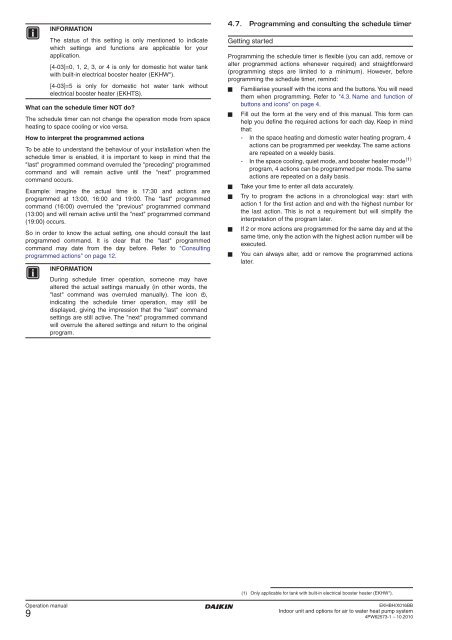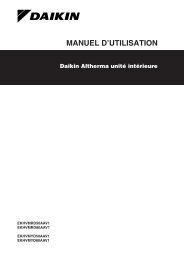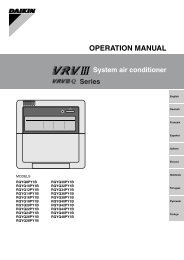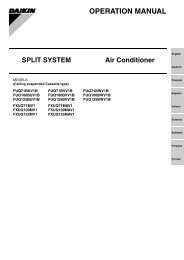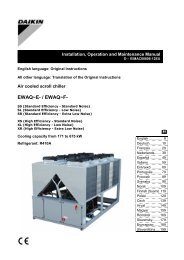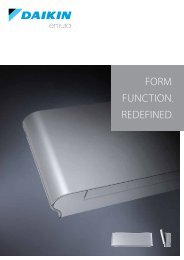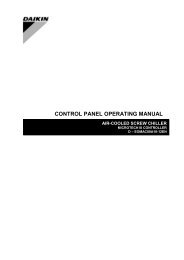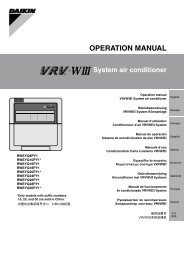EKHB(H) - Daikin
EKHB(H) - Daikin
EKHB(H) - Daikin
You also want an ePaper? Increase the reach of your titles
YUMPU automatically turns print PDFs into web optimized ePapers that Google loves.
INFORMATION<br />
The status of this setting is only mentioned to indicate<br />
which settings and functions are applicable for your<br />
application.<br />
[4-03]=0, 1, 2, 3, or 4 is only for domestic hot water tank<br />
with built-in electrical booster heater (EKHW*).<br />
[4-03]=5 is only for domestic hot water tank without<br />
electrical booster heater (EKHTS).<br />
What can the schedule timer NOT do?<br />
The schedule timer can not change the operation mode from space<br />
heating to space cooling or vice versa.<br />
How to interpret the programmed actions<br />
To be able to understand the behaviour of your installation when the<br />
schedule timer is enabled, it is important to keep in mind that the<br />
"last" programmed command overruled the "preceding" programmed<br />
command and will remain active until the "next" programmed<br />
command occurs.<br />
Example: imagine the actual time is 17:30 and actions are<br />
programmed at 13:00, 16:00 and 19:00. The "last" programmed<br />
command (16:00) overruled the "previous" programmed command<br />
(13:00) and will remain active until the "next" programmed command<br />
(19:00) occurs.<br />
So in order to know the actual setting, one should consult the last<br />
programmed command. It is clear that the "last" programmed<br />
command may date from the day before. Refer to "Consulting<br />
programmed actions" on page 12.<br />
INFORMATION<br />
During schedule timer operation, someone may have<br />
altered the actual settings manually (in other words, the<br />
"last" command was overruled manually). The icon p,<br />
indicating the schedule timer operation, may still be<br />
displayed, giving the impression that the "last" command<br />
settings are still active. The "next" programmed command<br />
will overrule the altered settings and return to the original<br />
program.<br />
4.7. Programming and consulting the schedule timer<br />
Getting started<br />
Programming the schedule timer is flexible (you can add, remove or<br />
alter programmed actions whenever required) and straightforward<br />
(programming steps are limited to a minimum). However, before<br />
programming the schedule timer, remind:<br />
■ Familiarise yourself with the icons and the buttons. You will need<br />
them when programming. Refer to "4.3. Name and function of<br />
buttons and icons" on page 4.<br />
■ Fill out the form at the very end of this manual. This form can<br />
help you define the required actions for each day. Keep in mind<br />
that:<br />
- In the space heating and domestic water heating program, 4<br />
actions can be programmed per weekday. The same actions<br />
are repeated on a weekly basis.<br />
- In the space cooling, quiet mode, and booster heater mode (1)<br />
program, 4 actions can be programmed per mode. The same<br />
actions are repeated on a daily basis.<br />
■ Take your time to enter all data accurately.<br />
■ Try to program the actions in a chronological way: start with<br />
action 1 for the first action and end with the highest number for<br />
the last action. This is not a requirement but will simplify the<br />
interpretation of the program later.<br />
■ If 2 or more actions are programmed for the same day and at the<br />
same time, only the action with the highest action number will be<br />
executed.<br />
■ You can always alter, add or remove the programmed actions<br />
later.<br />
(1) Only applicable for tank with built-in electrical booster heater (EKHW*).<br />
Operation manual<br />
9<br />
<strong>EKHB</strong>H/X016BB<br />
Indoor unit and options for air to water heat pump system<br />
4PW62573-1 – 10.2010


